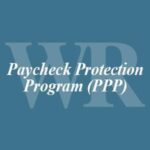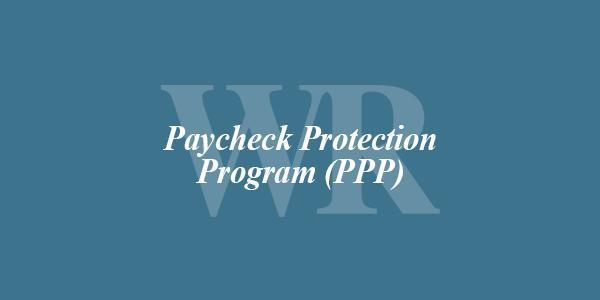
Coronavirus Relief Bill Passed- final version changes
December 22, 2020
WR SALT News: South Carolina Issues Tax Legislative Update for 2020
January 8, 2021CAA (relief bill) Signed Into Law on Dec. 27th- Important Things to be Aware Of

The Consolidated Appropriations Act of 2021 (CAA) was signed into law on December 27th, 2020. If you missed our previous email discussing what was included in the bill, below we go over the highlights of items that are important for you to be aware of.
Employee Retention Credit Extended and Modified
The CAA extends the employee retention credit until July 1, 2021 (previously it ended January 1, 2021). Some aspects of the credit were modified retroactively and some were modified only for the first two quarters of 2021.
The change for 2020 is that businesses that received PPP loans are now eligible to claim the credit. Previously companies that received PPP loans were not eligible. Following are the basics of the credit for 2020.
- You qualify if you experienced more than 50% reduction in gross receipts for any quarter in 2020 compared to the same quarter in 2019
- It is a 50% credit on qualified wages paid up to $10,000 total per employee
- If you had fewer than 100 FTEs in 2019, all wages paid in qualified quarters could qualify
- If you had more than 100 FTEs in 2019, only wages paid to employees while they were not providing services could qualify
- You cannot “double-dip” with other credits or PPP funds…so no wages paid using forgiven PPP dollars qualify for the credit
- This is a federal payroll tax credit claimed on your quarterly 941s
Thoughts: If you received a PPP loan you likely have not paid attention to this credit until now. Take a look at your gross receipts by quarter for 2020 compared to 2019. Especially for businesses with under 100 FTEs in 2019, if you experienced more than a 50% reduction for any quarter we should look and see if this credit will benefit you.
Moving forward in the first two quarters of 2021, there are more changes to the employee retention credit. They are:
- Employers with under 500 employees can claim the credit on all wages paid if there is a reduction in gross receipts of more than 20% for the first or second quarter of 2021 compared to the same quarter in 2019
- It is a 70% credit on qualified wages paid up to $10,000 per employee in a qualified quarter
- You still cannot “double dip” with other credits or PPP funds (see PPP2 info below)
Thoughts: If you end up having more than 20% less in gross receipts in Q1 or Q2 of 2021 as compared to the same quarter in 2019, this credit is something we need to consider.
First Round PPP Changes
The CAA makes three primary changes to initial PPP loans:
- Expands eligible PPP expenses. The following expenses are now qualified under PPP:
- Group Life, Disability, Vision or Dental Insurance is included as payroll costs
- Software or Cloud Computing expenses that facilitate business operations (product or service delivery, sales and billing, accounting or tracking supplies, HR, payroll, etc.)
- Costs related to property damage from public disturbances in 2020 not covered by insurance or other funds
- Certain supplier costs
- Certain worker protection expenditures
- Makes forgiveness process for loans under $150,000 easier
- SBA has been charged with creating a new one-page forgiveness application for loans under $150k
- This new application will likely not require backup documentation to be submitted to the bank, but borrowers will still need to attest they complied with PPP rules
- Backup documentation will still need to be maintained by borrowers: 4 years for employment records, 3 years for other records
- Allows PPP Expenses to be deducted
- This is big news because without this the loan funds were in essence taxable
Thoughts: For all borrowers who received PPP loans of $150k or less, we recommend waiting until the new forgiveness application is released along with the instructions before applying. We feel like the new process will be easier. For those loans over $150k, there was no change to the forgiveness process.
For most borrowers the extended 24-week covered period meant there were no issues using all of the PPP funds on qualified expenses. For the relatively few borrowers who didn’t have enough qualified expenses previously to maximize loan forgiveness, these expanded qualified expenses should help.
Keep in mind the requirement to use at least 60% of loan funds on qualified payroll and to use all of the funds only on qualified expenses is still in place for all borrowers. Borrowers with loans over $150k are still subject to forgiveness reductions due to FTE and/or wage reductions.
Second Round of PPP (PPP2)
A second round of PPP funds (PPP2) will be available sometime soon. The SBA will likely need to release a new loan application with instructions before banks begin accepting applications. Following are the criteria to be eligible for PPP2 based on the CAA…we still need final guidance from SBA.
- The borrower must employ no more than 300 employees, or meet an alternative size standard. For businesses with multiple locations, there must be fewer than 300 employees per physical location.
- The borrower must demonstrate that there was a 25% reduction in gross receipts in any quarter of 2020 compared to the same quarter in 2019.
- For the purposes of this 25% rule, gross receipts will include all revenues from the normal operation of the business before subtraction of expenses but will not include amounts borrowed, including amounts received for PPP loans.
Thoughts: We don’t yet know what documentation will be required to prove gross receipts were down more than 25% for any quarter in 2020. We have to wait and see what the guidance says. Companies can go ahead and begin looking at quarterly performance in 2020 compared to 2019 to see if they could be eligible for PPP2.
The loan amount calculation for PPP2 will be very similar (if not the same) as the first round for most companies. The loan amount will be 2.5 times average monthly payroll costs in 2019 or 2.5 times average monthly payroll costs for the 12 months prior to loan application. Note that these PPP2 loans will be capped at $2 million vs $10 million for the first round. Additionally, companies in the hospitality industry with a NAICS code beginning with 72 will be eligible for larger loans of 3.5 times average monthly payroll in their selected period.
PPP Eligibility for 501(c)(6) Organizations
Organizations classified as 501(c)(6) are now eligible for PPP loans if they:
- Have less than 300 employees
- Did not receive more than 15% percent of receipts from lobbying activities
- Lobbying did not make up more than 15% of the total activities of the organization
- The cost of all lobbying activities of the organization did not exceed $1,000,000 during the most recent tax year
EIDL Advance Grants Do Not Reduce Amount of PPP Forgiveness
The CARES Act established EIDL Advance grants of up to $10,000 for qualifying businesses. If a business received an EIDL Grant and then subsequently received a PPP loan, the amount of PPP forgiveness was to be reduced by the amount of the EIDL grant. The CAA removes this so that there is no reduction in forgiveness for those who received a PPP loan and an EIDL Grant.
EIDL Advance Grants Available Again
A new trough of dollars was put into the EIDL program and EIDL Grants of up to $10,000 are again available through December 31, 2021 for those businesses that qualify. To qualify, a business must be located in a low-income community (as defined under Code §45D), cannot have more than 300 employees, and must have a reduction in gross receipts of at least 30% during an 8-week period between March 2, 2020 and December 31, 2021 relative to a comparable 8-week period immediately preceding March 2, 2020 or during 2019.
Extension of Tax Credit for Employers Offering Qualified Paid Sick and Family Leave
The Families First Coronavirus Response Act created mandatory sick and family leave pay associated with COVID-19 along with payroll tax credits for the qualified pay. This required pay and credits were set to expire 12/31/20. The CAA removed the requirement to offer these benefits but extended the tax credits relating to qualified paid sick and family leave through March 31, 2021 for companies who voluntarily continue to offer the benefits in Q1 2021.
Thoughts: Continuing to offer this qualified sick and family leave benefit to employees in Q1 2021 is certainly something employers should consider…especially since the payroll tax credit for this pay is extended. Voluntarily continuing this benefit may help prevent those that have been exposed from coming to work and spreading the virus, while saving their PTO/sick/vacation days. Keep in mind that the credits are limited per employee and were originally a “one-shot” deal. We are waiting on guidance to see if credits could potentially be claimed in 2021 for qualified sick pay to an employee who already had qualified sick pay in 2020. Until we see otherwise we believe if the credit was taken already for sick pay for an employee, the credit cannot be taken again in 2021 for that same employee.
If you have questions or would like to strategically discuss your situation relative to any of these items, we are here to help. Reach out to your WR Partner or your relationship manager. You can also email our COVID-19 task force for assistance.


